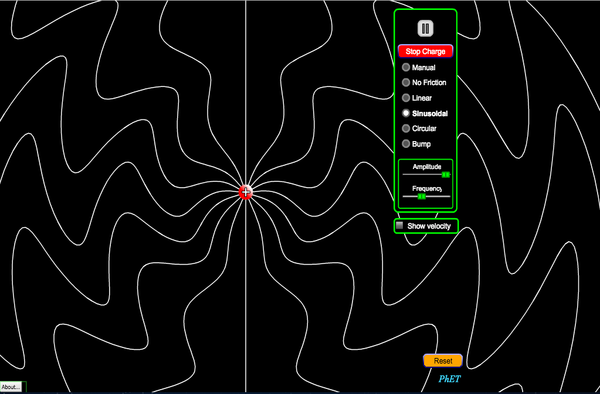Radiating Charge
Topics
- Electromagnetic Radiation
- Dipole Radiation
- Electric Field
- Speed of Light
Description
The electric field lines from a point charge evolve in time as the charge moves. Watch radiation propagate outward at the speed of light as you wiggle the charge. Stop a moving charge to see bremsstrahlung (braking) radiation. Explore the radiation patterns as the charge moves with sinusoidal, circular, or linear motion. You can move the charge any way you like, as long as you don’t exceed the speed of light.
Sample Learning Goals
- How the radial field line density depends on the speed of a charge in linear motion (compression of field lines).
- How the anisotropy of the field pattern depends on sinusoidal vs. circular motion.
- How the applied force and motion are related in relativistic dynamics (constant force does not result in faster-than-light travel).
- How acceleration produces transverse fields, while constant velocity produces radial fields.
- For sinusoidal motion, which produces dipole radiation, the field lines evolve from radial and static-like nearby, to transverse and plane-wave-like far away.
- How sudden deceleration of a charge produces bremsstrahlung (braking) radiation.
Version 1.03
Keywords
Teacher-Submitted Activities
| Title |
|
|
Authors | Level | Type | Subject |
|---|---|---|---|---|---|---|
| Alignment of PhET sims with NGSS |
|
Trish Loeblein | HS | Other | Biology Chemistry Earth Science Physics |
|
| How do PhET simulations fit in my middle school program? |
|
Sarah Borenstein | MS | Other | Physics Chemistry Earth Science Biology |
|
| MS and HS TEK to Sim Alignment | Elyse Zimmer | MS HS |
Other | Physics Biology Chemistry |
| Windows | Macintosh | Linux |
|---|---|---|
|
Microsoft Windows XP/Vista/7/8.1/10 Macromedia Flash 9 or later
|
OS X 10.9.5 or later Macromedia Flash 9 or later
|
Macromedia Flash 9 or later
|
| Design Team | Third-party Libraries | Thanks To |
|---|---|---|
|










